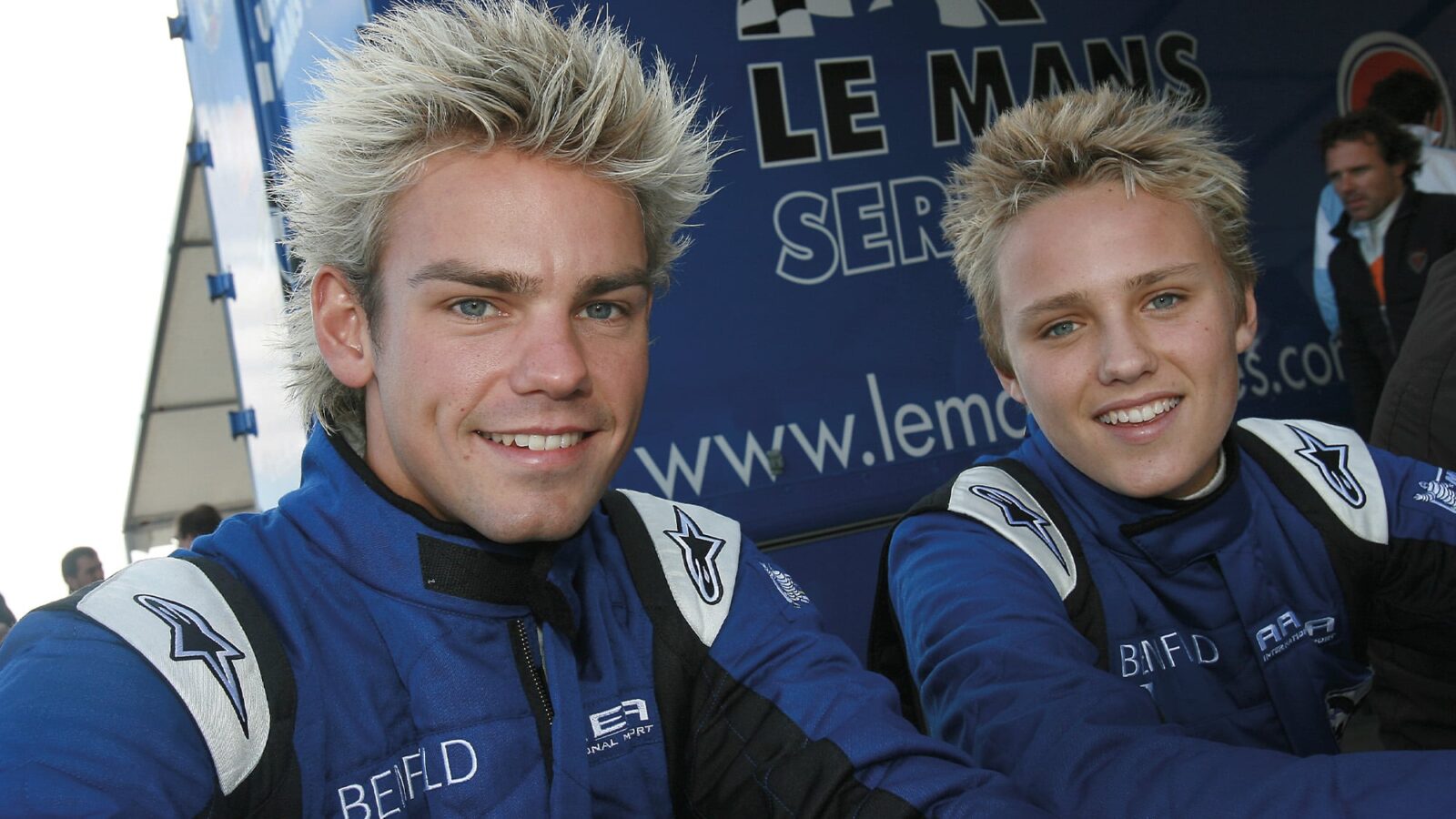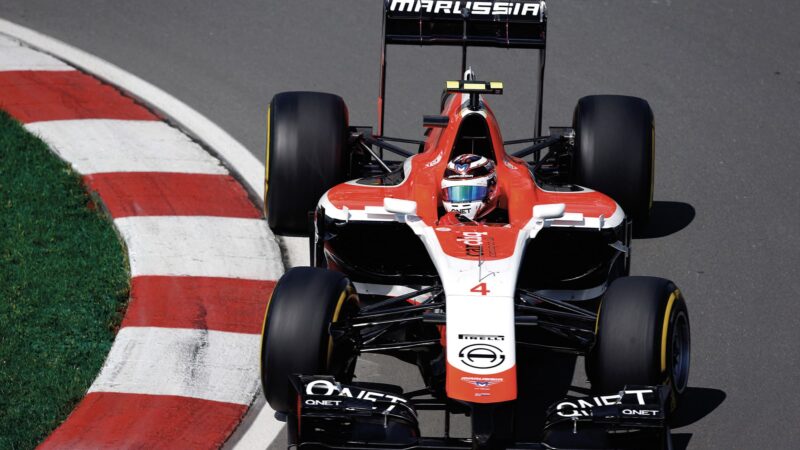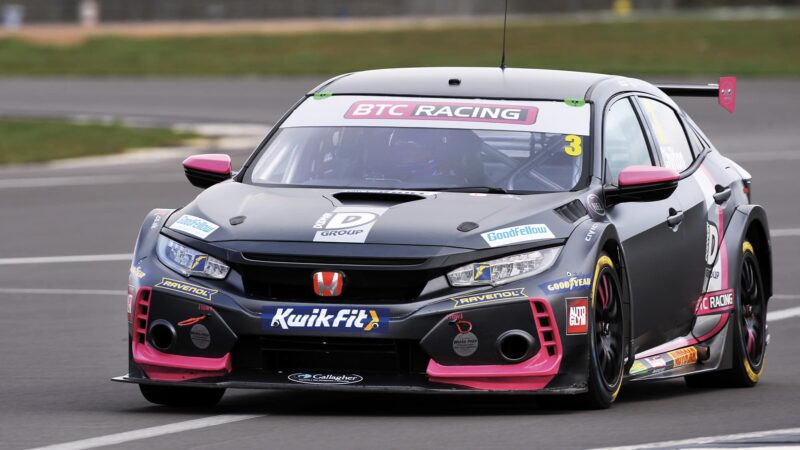Racing Lives: Max & Tom Chilton
The Chilton brothers started their racing careers young. Max went on to compete in Formula 1 and IndyCar; Tom has found success in British and World touring cars

Tom (left) and Max have shared a car before, forming two-thirds of the Arena Motorsports Zytek LMP1 team in the 2007 Le Mans Series
Jean Michel le Meur/DPPI
It almost feels like the Chiltons have been around with the British and international racing scenes for a lot longer than they actually have.
Both brothers started their careers young and, while Tom has gone on to achieve great success in tin-tops with wins in both the British and World Touring Car championships, younger brother Max sought the single-seater route. He became the youngest British Formula 3 driver – getting dispensation to join the series on the eve of his 16th birthday – before going on to race in Formula 1 with the Marussia team, and is now in IndyCar. The hair may be tamer these days, but the competitive instinct between them is as wild as ever.
Max Chilton
“I sometimes question whether we actually have the same parents because Tom’s so different to me. He’s the person that will light up a room and has the biggest heart in the world.
I’m very much like my Dad. I’m business-orientated and always looking for the next opportunity. But Tom doesn’t get it from my Mum, because she’s the youngest of six and she’s got a twin as well, so she’s very quiet and used to being trodden down by her older brothers and sisters, which made her quite an insular person. She’s not similar to Tom; he’s super-loud, the centre of attention, makes everyone laugh. My Dad jokes about it and says he must be the milkman’s…
Perhaps part of the reason he’s quite loud and extrovert is that he was bullied when he was at boarding school. He was overweight up to the age of about 14, at which point he got into T Car racing. He found his character and lost all his weight, and became motivated to be a racing driver. And once he became a racer he found all the confidence in the world.
He might be a big kid at heart but he absolutely loves motor sport and his knowledge is second to none – far superior to mine. He could probably be a race engineer if he wanted to. I’m ‘just a race driver’; I tell the engineers what’s wrong with the car, and I leave it to them to find a solution, whereas he tries to drive the car and find the solution.
I can remember sitting in the back of old Escorts as Dad’s mates drove around the fields. Then, for my seventh birthday, Dad got me an off-road go-kart and Tom had a quad bike and we’d spend holidays bombing about.
By the age of nine I got my first kart, and like pretty much 99 per cent of all the other kids in karting, my focus was to get to Formula 1, not touring cars. To my mind, karting was and remains the key to motor sport because it teaches you race craft at an early age. I say to people, if someone had a video of me karting and one of me onboard in an IndyCar today, they would see that it’s the same driver. The more years of practice you get, the more honed you get and the more successful you’ll be, mainly because you do a lot more racing in karting than you do in single-seaters, because there’s no downforce.
In my first season of F3 I signed up with Arena Motorsport. The team was run by Mike Earle, who used to run the Onyx F1 team, and he also ran Tom in touring cars. It was a great team, but they were also new to F3 and didn’t have any data to work with. So then came a switch to HiTech, in 2008, and the following year I moved to Carlin, which is really where I should have started in the first place. So my advice to anyone serious about making it in motor sport is to pick the best team you can and have two back-to-back years with them, because it’s amazing how much difference there is between the first and second year.
Another decision I’m often asked about is whether I should have spent another year in F3 and won the championship? In 2009 I was battling with Daniel Ricciardo [Chilton finished fourth in the points with one win] – but I wanted to keep moving up and racing against the best people, so I moved to GP2, and I don’t think I’d have got my break in Formula 1 if I hadn’t done that.

Max Chilton made 35 F1 starts with Marussia before the team folded
Tom Pennington/Getty Images
And I’m pleased I made it. The trouble was, I was faced with the harsh realities of F1: money. I think Marussia had about $70m compared with Mercedes, which may have been spending around $400m. The second year was tougher still. I’d got super-fit during off-season training, felt my best and was performing well in testing, rattling Jules [Bianchi], but I found out before we headed for Melbourne that the team was in serious financial trouble. I knew every race would be a luxury. And what was particularly difficult for me was that other than the team’s directors, nobody else knew and I had to just get on with the task at hand. It’s one of the few times I’ve seen my Dad cry. He spent the whole year trying to help find a backer for the team and it fell through.
F1 is a falsified world, one that’s become so machine-based. Just look at Fernando Alonso and his twilight years in F1. Here was one of the fastest drivers in the world, without the car to do the job. That’s what made it such a nice change moving to IndyCar. Everyone’s got the same car, there’s two different engines, each team plays its part but generally it’s down to the driver to make the difference. And hopefully our attempt at the Indy 500 will prove to be more successful than last year’s… [when he failed to make the field].”
Tom Chilton
“Driving for me started when I was about eight and around nine stone, with a 44-inch waist. Dad was at the pub with some of his mates and they said, ‘Wouldn’t it be fun if we all found some failed MOT Ford Escort MkIIs, put out some hay bales in the field, made a track in a figure of eight and did some racing?’ That’s what they did. It became a bit of a thing, then all the wives rightly complained that they were being left at home with the children while the men were off having fun. So they took a turn, only my mother didn’t want to take part, and Dad suggested I take her place. It
was brilliant fun.
I couldn’t fit in a kart, so it wasn’t until I reached 14 and was able to race in T Cars that I got a goal, a focus and a passion. At that point Dad was like, ‘You know, racing drivers are athletes, they are professional sportsmen. If you want to go around and have some fun and be last, that’s fine, you do that. But if you want to be the best and you want to win, you’ve got to get fit.’
That term I went to boarding school, Shiplake College, just outside Henley. I was doing a run in the morning and games in the afternoon, so two sessions a day, and the by the first winter term, which I think was 14 weeks later, I lost 10 inches from my waist.
Because I didn’t do any karting, we agreed with the headmaster that every Thursday, my driver coach and manager Andy Constable would pick me up and take me to Thruxton, where I’d learn about flags and racing lines. I realised that all I wanted to do is motor sport and so I focused on getting fit, losing weight, and wanting to be the best I could be.
And at the age of 16 I was already testing a British Touring Car, and then two weeks after turning 17 I got on the podium, during my first ever British Touring Car race, on the Brands Hatch GP Circuit [in 2002], which I’d never raced on before. It came naturally.
With the age gap between Max and I, we were competitive. We’d play racing games on the PlayStation, and we’d try to hit each other’s controller out of our hands.
Max, I would say, is more competitive than me. I remember when he was eight, racing in a Comer Cadet at Bayford Meadows in Kent. I can’t remember exactly what happened – he made a mistake or got punted off or similar – but he was so upset and angry that he was punching the steering wheel so hard he bent it – it was folded around the steering column. When he lifted up his visor there were these huge tears coming down his face.
I’m not like that at all. In fact I think that’s how you have to be to drive a touring car, because if you manhandle them or push too hard you just go slower. The best way to describe it is if you try and hit a golf ball harder and further, it usually doesn’t do that. You’ve just got to relax, and that’s like racing.

Tom’s current BTC Racing Honda Civic British Touring Car
Jakob Ebrey
It’s nice we found our niches in racing. We both support each other but he never needed any race craft advice from me, just some practical tips. I remember when he was about 10 and I was about 16, we were racing around the field and Max managed to barrel- roll his Mini grasstrack car after hitting some ruts we’d carved. I remember running up to Max, and talking him through how the first thing you do is you switch off the power to stop fuel pumping, check for fire, if there is you hit that button there, and before you undo your seatbelts put one hand on the roof because you will fall out your seat.
Being a big guy, touring cars are the best fit for me. But it felt strange to me – a 17-year- old teenager – to find myself thrust into this spectacular show, where I was signing something like 600 autographs in a race weekend, found myself posing for selfies with people and had all these race fans queuing up to meet me. I guess the younger fans loved the fact that I was a young driver.
I love driving so much. Yet equally I can stand at the side of a racetrack, and get this itching feeling that I want to engineer everybody. I’ll position myself where you can see how a car’s behaving, and do enjoy the engineering side of things.
As for the bucket list, I still haven’t ticked off the Le Mans 24 Hours and Bathurst 24 Hours. I’m working on it.”
